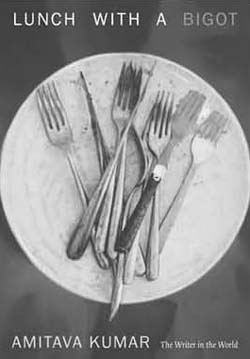Amitava Kumar’s Lunch with a Bigot is divided into four main sections— Reading, Writing, Places and People. They offer a road map to navigate through the different articles that were written and published in diverse places.
In the first section, there is a journey through his childhood experience and him emerging as a person who was grasping varied experiences and incorporating them as his ‘resource bank’. I have recently read Sudhir Kakkar’s memoirs and the narration of his own childhood. In my mind, there is an intermingling of his narration with that of Amitava’s in terms of the evocative details offered of the experience. I could recollect my own initial visits to my ancestral village where the toilet was located at a distance from the main house. A hole dug in the ground and the outward passage to the other side of the wall. The access to those manually cleaning the toilets lay outside the boundary wall and this job of cleaning was delegated to the jamadar, the lower caste. These were the people who were so essential, yet it was ensured that they were kept at a distance. The grandparents would ensure that this distance was maintained, when food was given the grandmother would keep an eagle eye to see that separate plate and glass were used. She felt that the young blood from the city would not maintain the rules of sanctity, thus bringing najasat within the home, making it difficult to keep her home pak. I would be fascinated while standing at the threshold of the house and watch the abandon with which their children would run around the neighbourhood and yet I would be instructed to stay within as it was not ‘appropriate’ for the family that I belonged to.
Kumar offers a glimpse into his life, his thoughts, his struggles and each story in this book I feel is relevant for us in the present times. Arundhati, Naipaul, Rushdie, Khureshi some of the authors that he includes are making a statement with respect to some emerging realities of Indian society. Through their writing they are being activist—though Arundhati is mentioned as being uncomfortable with the usage of the term in reference to her.

